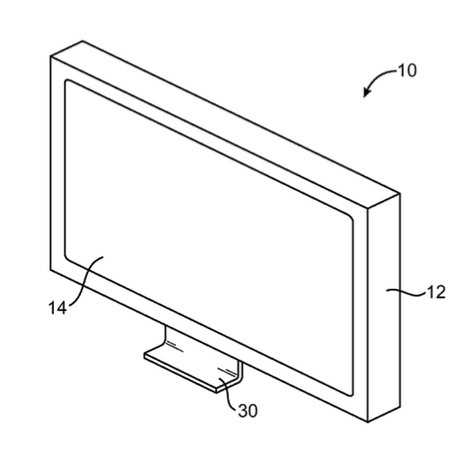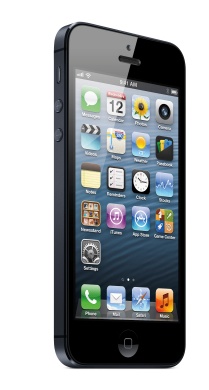Apple has been granted a patent (number 8269677) by the U.S. Patent & Trademark Office for a dual-band cavity backed antenna for an integrated desktop computer — in other words, the iMac.
Per the patent, an electronic device may have a housing with conductive housing walls. A dielectric antenna window may be formed in an opening in one of the conductive housing walls. A dielectric logo may form the dielectric antenna window. A dielectric support structure may have an outline that matches the dielectric logo. An antenna resonating element for an antenna may be formed on the dielectric support structure.
An antenna cavity for the antenna may be formed by a conductive cavity structure. A pattern of voids in the dielectric support structure may reduce dielectric loading for the antenna. The conductive cavity structure may be formed from solderable plated metal. The conductive cavity structure may have a planar lip that is attached to the conductive housing walls using conductive adhesive. Rear wall portions of the conductive cavity structure may be oriented at a non-perpendicular non-zero angle with respect to the planar lip.
Here’s Apple’s background on the invention: “Electronic devices such as computers and communications devices are often provided with wireless communications capabilities. For example, electronic devices may use long-range wireless communications circuitry such as cellular telephone circuitry to communicate using cellular telephone bands at 850 MHz, 900 MHz, 1800 MHz, and 1900 MHz (e.g., the main Global System for Mobile Communications or GSM cellular telephone bands).
“Long-range wireless communications circuitry may also be used handle the 2100 MHz band and other bands. Electronic devices may use short-range wireless communications links to handle communications with nearby equipment. For example, electronic devices may communicate using the WiFi (IEEE 802.11) bands at 2.4 GHz and 5 GHz (sometimes referred to as local area network bands) and the Bluetooth band at 2.4 GHz.
“It can be difficult to incorporate antennas successfully into an electronic device. Space for antennas is often limited within the confines of a device housing. Antenna operation can also be blocked by intervening metal structures. This can make it difficult to implement an antenna in an electronic device that contains conductive display structures, conductive housing walls, or other conductive structures that can potentially block radio-frequency signals. It would therefore be desirable to be able to provide improved antennas for electronic devices.”
The inventors are Jerzy Guterman, Eduardo Lopez Camacho, Mattia Pascolini, Ayala Enrique Vazquez, Robert W. Schlub and Ruben Caballero
Apple was also granted a patent (number 8270914) for a bezel gap antenna, which is apparently the ones used in the iPhone 4 — and which was the object of the “antennagate” brouhaha.
Other Apple patents granted recently are:
° Patent number 8269093 for methods for beat synchronization between media assets;
° Patent number 8269094 for a system and method that enables a user to generate and manipulate string-instrument chord grids in a digital audio workstation;
° Patent number 8269453 for a battery charging system for mobile and accessory devices;
° Patent number 8269675 for antennas for electronic devices with a conductive housing;
° Patent number 8269727 for techniques for identifying irregular objects in contact with, or in close proximity to, a touch-surface;
° Patent number 8269763 for techniques for providing a refresh of a scene;
° Patent number 8269780 for a method and an apparatus for updating graphics resource usage according to a stream of graphics commands atomically submitted to a graphics processing unit (GPU);
° Patent number 8269816 for video encoding in a video conference;
° Patent number 82670246 for optimized selection of memory chips in multi-chip memory devices;
° Patent number 82670489 for dynamic dithering for video compression;
° Patent number 82670630 for automatic and dynamic noise cancellation for microphone-speaker combinations;
° Patent number 82670809 for systems and an apparatus to perform methods including receiving input to apply attributes that represent modifications to appearance of content of the video segment, to a video segment;
° Patent number 82670935 for a method and system for prolonging emergency calls;
° Patent number 82671038 for a wireless adapter for a media player system;
° Patent number 82671114 for a protocol for a remote user interface for a portable media device;
° Patent number 82671445 for storage, organization and searching of data stored on a storage medium;
° Patent number 82671470 for auto-activation of fonts;
° Patent number 82671670 for a method and apparatus for media data transmission;
° Patent number 82671705 for a dual key electronic connector;
° Patent number 82671812 for hardware automatic performance state transitions in system on processor sleep and wake events;
° Patent number 82671832 for non-faulting and first-faulting instructions for processing vectors;
° Patent number 82671872 for a technique for aligning a plurality of media clips;
° Patent number 82672048 for systems and methods for restricting program process capabilities;



